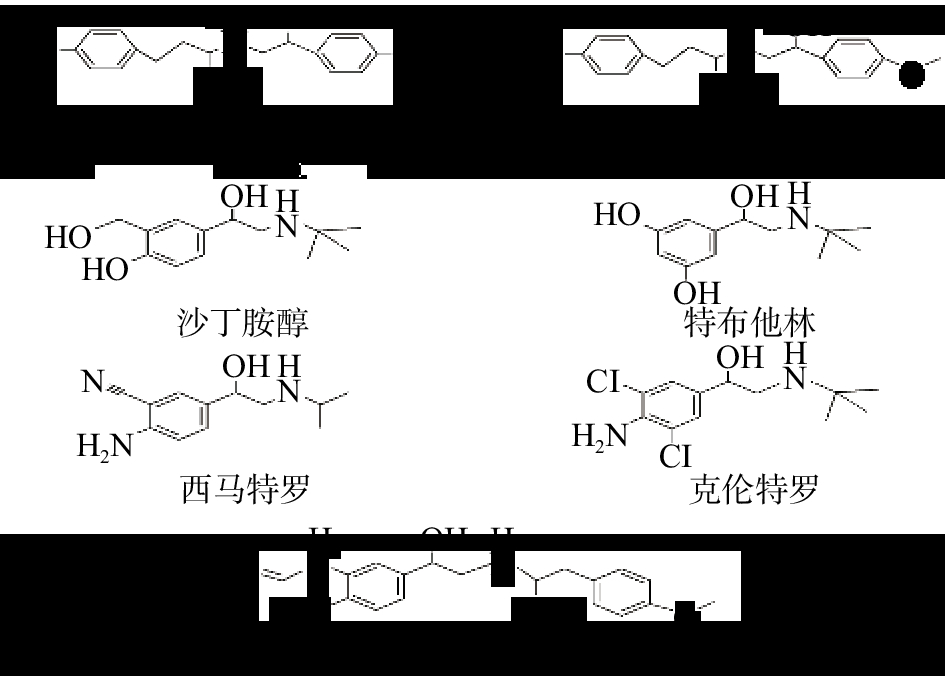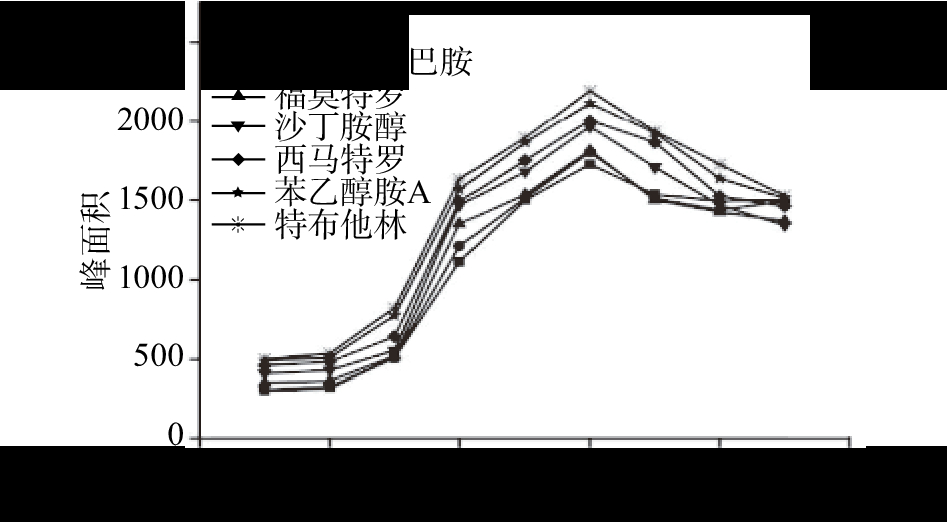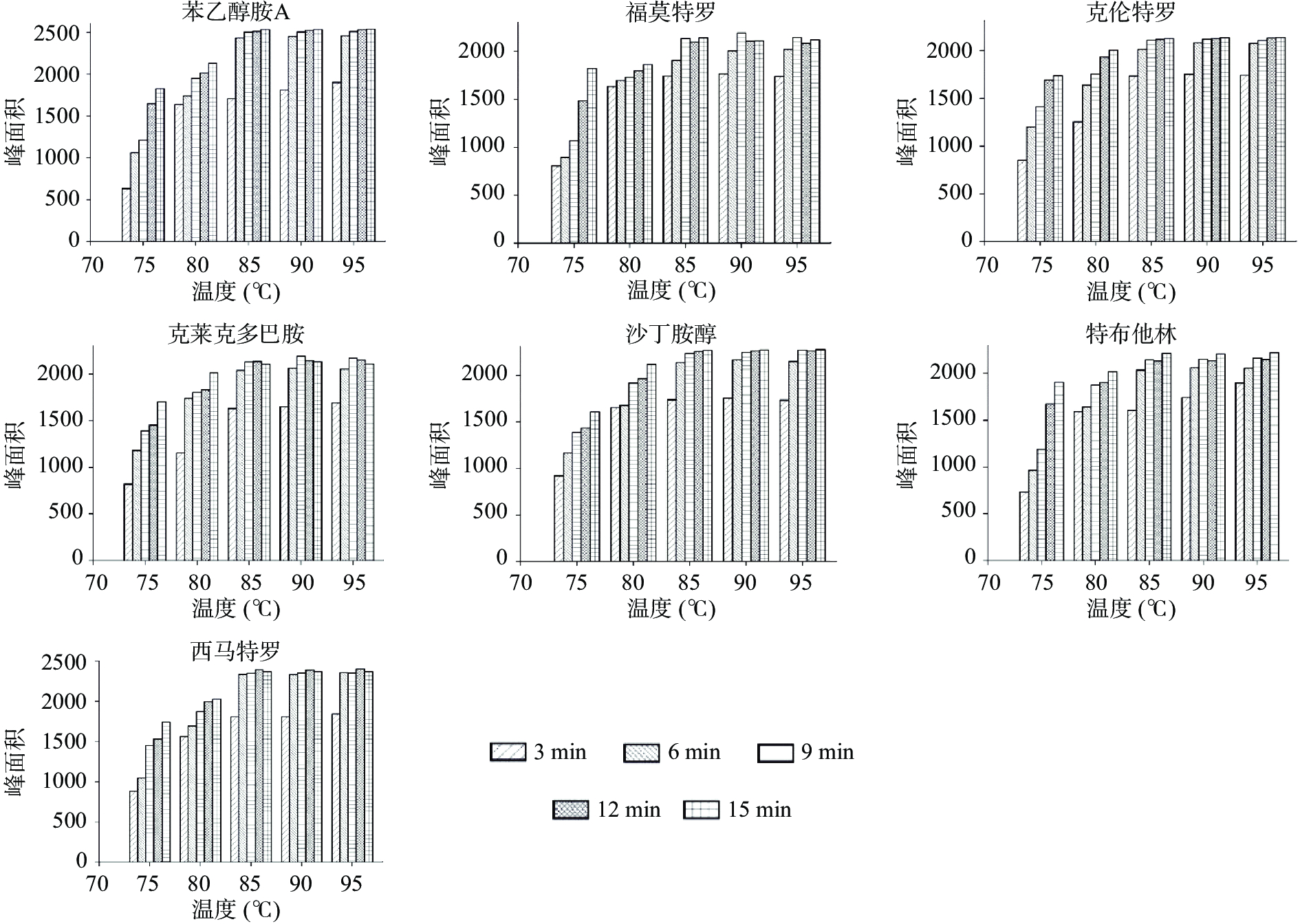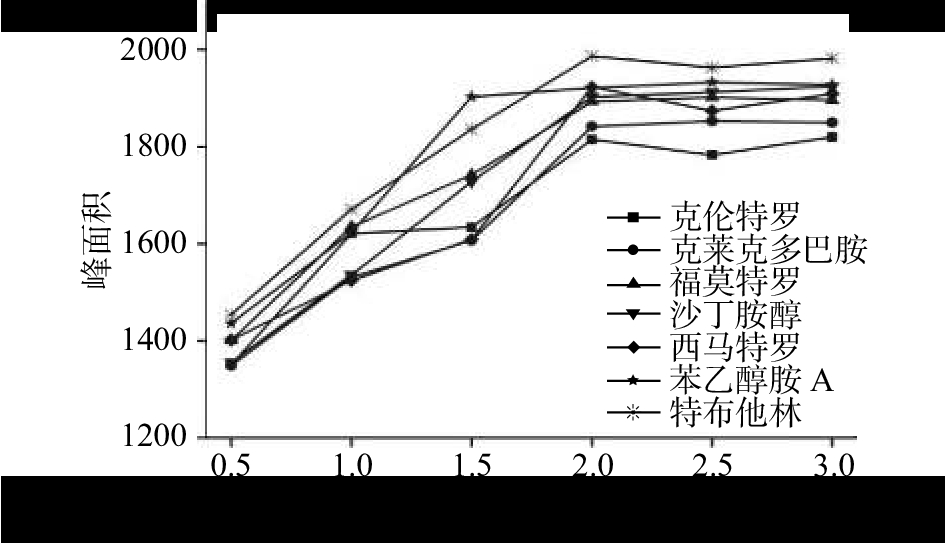Detection of 7 β-agonists in Animal-derived Food based on Ionic Liquid and Pre-column Fluorescence Derivatization-High Performance Liquid Chromatography
-
摘要: 以荧光衍生剂2-(4-磺酰氯基苯基)苯并咪唑和7种β-受体激动剂发生反应,达到增强7种β-受体激动剂荧光强度的目的,建立了动物性食品中7种β-受体激动剂的高效液相色谱-荧光检测方法。研究了碳酸盐缓冲溶液pH、反应温度、反应时间和2-(4-磺酰氯基苯基)苯并咪唑的浓度对衍生反应的影响。结果表明:在最优实验条件下,7种β-受体激动剂在1.0~100.0 ng/mL范围内呈良好的线性关系,线性相关系数R2>0.999,检出限约为0.30 μg/kg,定量限<1.0 μg/kg。空白猪肉、羊肉、牛肉样品在1.0、10.0、50.0 μg/kg这三个不同浓度水平进行加标实验,回收率分别为81.3%~107.3%、80.5%~110.7%和80.2%~105.1%,日内相对标准偏差分别为1.48%~13.51%、1.26%~12.33%和1.23%~11.49%,日间相对标准偏差分别为2.21%~11.54%、1.82%~13.31%和1.07%~13.21%。该方法精密度好、准确度高,抗干扰能力强,适合动物性食品中7种β-受体激动剂残留量的定性确证分析和定量分析。
-
关键词:
- 2-(4-磺酰氯基苯基)苯并咪唑 /
- 荧光衍生剂 /
- β-受体激动剂 /
- 动物性食品 /
- 高效液相色谱
Abstract: In order to enhance the fluorescence intensity of 7 β-agonists, the fluorescent derivatizer 2-(4-sulfoyl chloro-phenyl) benzimidazole reacted with β-agonists, a high performance liquid chromatography-fluorescence detection method for 7 β-agonists in animal-derived food was established. Effects of pH of carbonate buffer solution, reaction temperature, reaction time and concentration of 2-(4-sulfoyl chloro-phenyl) benzimidazole on the fluorescence derivatization were investigated. The results showed that 7 β-agonists had a good linearity in the range of 1.0~100.0 ng/mL and the correlation coefficient (R2) was higher than 0.999 under the optimal conditions. The limits of detection for 7 β-agonists were about 0.30 μg/kg, and the limits of quantitation were less than 1.0 μg/kg. The recoveries of blank pork, mutton and beef samples at three different concentrations of 1.0, 10.0 and 50.0 μg/kg were 81.3%~107.3%, 80.5%~110.7% and 80.2%~105.1%, the intra-day and the inter-day relative standard deviations were 1.48%~13.51%, 1.26%~12.33%, 1.23%~11.49% and 2.21%~11.54%, 1.82%~13.31%, 1.07%~13.21%, respectively. Therefore, the developed method is suitable for determination of 7 β-agonists in animal-derived food qualitatively and quantitatively with satisfactory sensitivity, selectivity, accuracy and precision. -
β-受体激动剂属苯乙醇胺类药物,一般可分为三大类,含取代基的苯胺型(如克伦特罗)、苯酚型(如沙丁胺醇)、苯二酚型(如特布他林),结构式见图1[1-3]。该类药物的主要作用是加强心脏收缩、扩张骨骼肌血管支气管平滑肌,用于休克和哮喘的临床治疗[4-5]。β-受体激动剂类药物常被非法添加到饲料中,可以促进动物生长,减少脂肪沉积,提高瘦肉率,但长期使用会在动物组织中富集,人类食用后会产生很严重的毒副作用,从而危害人类健康[6-8]。欧美等发达国家已严禁在畜牧生产中应用[9],我国原农业部176号、1519号公告中明确规定严禁在动物饲养过程中使用该类药物,并将β-受体激动剂类列为动物源性食品中残留的重点监控药物[10-11]。
目前对β-受体激动剂的检测方法有免疫法[12-14]、电化学传感器法[15-16]、高效液相色谱法[17-18]、质谱法[19-22]等。其中,免疫法检测速度快,但易出现假阳性,稳定性和灵敏性有待提高,仅作为初筛方法,适用于大批量样品的快速筛查[3]。电化学传感器法目前还不够完善,在实际检测工作中应用较少,需进一步研究[23]。质谱法灵敏度高,重复性好,假阳性低,但仪器昂贵,过程较繁琐,前处理步骤复杂[24]。高效液相色谱是常见检测β-受体激动剂的方法,但由于受基质干扰,导致检测灵敏度降低,需要对样品进行提纯或富集预处理[25]。离子液体因不易挥发、温度范围广、对有机物无机物溶解性好、阴阳离子的组合可设计性等独特的优势而得到广泛应用,尤其在样品前处理中起到提纯和富集目标检测物的作用,达到减少基质干扰和提高检测灵敏度的目的,从而成为研究的热点[26]。陈惠芳等[27]采用绿色环保的离子液体1-己基-3-甲基咪唑四氟硼酸盐和双三氟甲烷磺酰亚胺锂,超声原位合成了1-己基-3-甲基咪唑双三氟甲磺酰亚胺盐,应用于萃取富集样品中的硫酸沙丁胺醇和盐酸莱克多巴胺,建立了离子液体液液微萃取-高效液相色谱分析饲料、动物内脏和肌肉中的硫酸沙丁胺醇和盐酸莱克多巴胺的方法,该方法具有简便快捷、萃取效果好和试验仪器简单的优点。
本研究在已有研究的基础上[28-31],利用实验室合成的荧光衍生剂离子液体2-(4-磺酰氯基苯基)苯并咪唑[30]和动物性食品中β-受体激动剂发生反应,极大提高了β-受体激动剂检测灵敏度,以期达到简单、快速、准确的检测目的。
1. 材料与方法
1.1 材料与仪器
氯化钠和碳酸钠 分析纯,天津市凯信化学工业有限公司;正己烷、乙腈和甲醇 色谱纯,北京百灵威科技有限公司;盐酸和乙酸铵 色谱纯,西陇科技股份有限公司;克伦特罗(97.5%)、莱克多巴胺(99.0%)、沙丁胺醇(98.7%)、西马特罗(99.0%)、苯乙醇胺A(99.6%)、特布他林(98.0%)、福莫特罗(96.0%) 德国Dr. Ehrenstorfer公司;邻苯二胺、苯甲酰氯、氯磺酸、丹磺酰氯 分析纯,上海麦克林生化科技有限公司;1-丁基-3甲基咪唑六氟磷酸盐 本实验室合成;牛肉、羊肉和猪肉 随机购于市场及超市。
20A型液相色谱仪(荧光检测器) 日本岛津科技有限公司;RE-52AA型旋转蒸发仪 上海亚荣生化仪器厂;RX-II型离心机 天美中国科学仪器有限公司;JJ500电子天平 常熟市双杰测试仪器厂。
1.2 实验方法
1.2.1 荧光衍生剂合成
荧光衍生剂2-(4-磺酰氯基苯基)苯并咪唑合成过程详见本实验室已发表文章[30],其合成路线见图2。
1.2.2 样品处理
称取5.00 g样品于50 mL离心管中,加入25 mL样品提取液(甲醇:0.2 mol/L盐酸:20 g/L氯化钠的体积比为1:1:1),涡旋混匀后超声提取2 min,于8000 r/min离心5 min,上清液转移至鸡心瓶中,使用5 mL提取液重复提取(甲醇:0.2 mol/L盐酸:20 g/L氯化钠的体积比为1:1:1),合并上清液至鸡心瓶中,50 ℃浓缩至小于5 mL,加入10 mL正己烷,涡旋混匀,静置分层后弃去上层正己烷,下层用蒸馏水定容至5 mL,待用[27]。
1.2.3 衍生反应
准确吸取1 mL 1.2.2处理的样液于具塞试管中,加入1 mL衍生缓冲液(pH10.0,0.1 mol/L碳酸钠溶液),1 mL衍生剂2-(4-磺酰氯基苯基)苯并咪唑溶液(2.0 mg/mL溶于丙酮),混匀后加塞,在避光的条件下85 ℃反应9 min,冷却后加入0.05 mL浓盐酸混匀,过0.45 μm的滤膜,待测。
1.2.4 标准溶液配制
分别准确称取七种β-受体激动剂标准品100 μg于100 mL容量瓶,甲醇定容配制成浓度为1.0 μg/mL的混合标准储备液,分别吸取0.01、0.05、0.1、0.5、1.0 mL于10.0 mL容量瓶,甲醇定容得1.00、5.00、10.00、50.00、100.00 ng/mL 7种β-受体激动剂系列混合标准溶液,准确吸取1 mL按1.2.3进行衍生处理后,待测。
1.2.5 色谱条件
色谱柱:C18(4.6×250 mm)分析柱;流动相:pH3.5的乙酸铵缓冲液(v)+乙腈(v)=40+60;流速:1 mL/min;柱温:40 ℃;进样量:20 μL;激发波长:365 nm,发射波长:405 nm。
1.2.6 碳酸盐缓冲溶液pH优化
本试验为了研究不同pH对衍生剂2-(4-磺酰氯基苯基)苯并咪唑与7种β-受体激动剂反应的影响,配制pH分别为5.0、6.0、7.0、8.0、9.0、10.0、11.0、12.0、13.0的碳酸盐缓冲溶液。不同pH条件下在猪肉中加标10.0 ng/mL 7种β-受体激动剂混合标准溶液,按照1.2.2和1.2.3步骤进行处理。
1.2.7 衍生反应温度和反应时间优化
在猪肉中加标 10.0 ng/mL 7种β-受体激动剂混合标准溶液,按照1.2.2和1.2.3步骤,在不同温度75、80、85、90、95 ℃条件下,分别反应3、6、9、12、15 min。
1.2.8 2-(4-磺酰氯基苯基)苯并咪唑浓度优化
分别配制浓度为0.5、1.0、1.5、2.0、2.5、3.0 mg/mL荧光衍生剂2-(4-磺酰氯基苯基)苯并咪唑。在猪肉中加标 10.0 ng/mL 7种β-受体激动剂混合标准溶液,按照1.2.2和1.2.3步骤,不同浓度荧光衍生剂2-(4-磺酰氯基苯基)苯并咪唑分别与10 ng/mL 7种β-受体激动剂混合标准溶液进行衍生反应。
1.2.9 荧光强度对比
按照步骤1.2.3分别利用2-(4-磺酰氯基苯基)苯并咪唑和丹磺酰氯衍生含有1.0 μg/kg莱克多巴胺的阳性样品,对比衍生产物荧光强度,以色谱峰面积大小评价荧光强度大小。
1.2.10 加标回收实验
对阴性样品进行加标回收实验来考察方法的准确度和精密度。按照1.2.2处理样品,各加入1.0 μg/mL的七种β-受体激动剂储备液5、50、250 μL,得到低、中、高三个不同浓度1.0、10.0、50.0 μg/kg加标水平的阳性样品,不同基质和不同加标水平的阳性样品各制备5份,依据1.2.3衍生,1.2.5测定,计算平均回收率、日内相对标准偏差和日间相对标准偏差。
1.2.11 实样分析
利用1.2.2和1.2.3步骤处理,对市场购买的10份猪肉、10份羊肉和10份牛肉样品进行定性定量分析。
1.3 数据处理
数据均采用Excel软件进行计算分析,图采用ChemDraw和Origin 8.5软件进行绘制分析。
2. 结果与分析
2.1 碳酸盐缓冲溶液pH对衍生反应的影响
由图3结果可知,随着pH的增加,7种β-受体激动剂峰面积先增加后减小,当pH为10.0时峰面积最大,说明衍生剂2-(4-磺酰氯基苯基)苯并咪唑可以快速有效的进攻β-受体激动剂中的仲胺基团,生成唯一产物,便于分析检测。当pH为酸性时,不利于衍生反应的进行;当pH为弱碱性时,衍生反应速度慢,前处理比较费时;当pH>10.0时由于碱性过强,衍生剂2-(4-磺酰氯基苯基)苯并咪唑会与目标物中仲胺基以外的基团反应,导致目标物含量减少,副产物含量增加,不利于分析检测[30]。故本实验选择pH10.0为最佳碳酸盐缓冲溶液条件。
2.2 温度和时间对衍生反应的影响
由于常温条件下,该衍生反应耗时较长,故对本实验进行加热处理,选择合理的反应温度与反应时间,从而减少前处理时间。由图4可知,随着温度和时间的增加,7种β-受体激动剂峰面积随之增加,当温度升至85 ℃,反应9 min时,峰面积基本达到最大,之后随温度和时间的增加,峰面积增加不明显。说明在温度85 ℃,反应9 min条件下衍生反应基本能反应完全,故本实验选择85 ℃环境中反应9 min为最佳衍生条件。
2.3 2-(4-磺酰氯基苯基)苯并咪唑浓度对衍生反应的影响
由图5可知,随衍生剂浓度的增加,衍生产物的峰面积也相应增加,当衍生剂浓度达到2.0 mg/mL后,衍生产物峰面积基本不再增加,说明当衍生剂浓度达到2.0 mg/mL时,能够保证衍生反应的完全进行,且衍生产物峰面积并不随衍生液浓度而增加,故本实验选择2.0 mg/mL为最佳衍生剂浓度。
2.4 荧光强度对比
2-(4-磺酰氯基苯基)苯并咪唑为苯并含氮杂环,丹磺酰氯为萘环,无给电子基团,对衍生产物的荧光强度增加作用不明显。而2-(4-磺酰氯基苯基)苯并咪唑结构中有氨基为给电子基团,能使得杂环的电子共轭区域增大,大幅增加衍生产物的荧光强度,在液相色谱中得到更强的荧光信号,从而有利于提高方法的灵敏度,更适用于痕量检测工作中。由表1可知,2-(4-磺酰氯基苯基)苯并咪唑衍生产物的荧光强度是丹磺酰氯衍生产物的1.82倍。
表 1 两种衍生剂荧光强度比较Table 1. Comparison of fluorescence intensity of two derivatives衍生剂 色谱峰高 色谱峰面积 2-(4-磺酰氯基苯基)苯并咪唑 5.63 35573 丹磺酰氯 2.94 19546 2.5 线性范围、检出限和定量限
按照1.2.4步骤配制标准溶液进行检测,在最佳的实验条件下测定,7种β-受体激动剂的荧光衍生产物分离度良好,且由于衍生的原因,选择性的减少基质杂质峰对目标峰的影响。以浓度为横坐标和峰面积为纵坐标绘制标准曲线,结果见表2。由表2可知,7种β-受体激动剂在1.0~100 ng/mL范围内呈良好的线性关系,线性相关系数R2>0.999。以3倍信噪比(S/N)计算检出限,得到7种β-受体激动剂检出限约为0.30 μg/kg,以10倍信噪比(S/N)得到7种β-受体激动剂定量限<1.0 μg/kg。
表 2 7种β-受体激动剂线性方程、检出限和定量限Table 2. Linear equations, detection limits and quantification limits of 7 β-agonists药物名称 线性范围(ng/mL) 回归方程 相关性系数R2 检出限(μg/kg) 定量限(μg/kg) 克伦特罗 1.0~100 y=93322x−18378 0.9992 0.30 0.90 莱克多巴胺 1.0~100 y=83342x−47769 0.9994 0.25 0.75 沙丁胺醇 1.0~100 y=123338x−47769 0.9991 0.30 0.90 西马特罗 1.0~100 y=137428x−51006 0.9995 0.35 0.96 苯乙醇胺A 1.0~100 y=925730x−13268 0.9997 0.26 0.78 特布他林 1.0~100 y=875506x−28490 0.9992 0.31 0.93 福莫特罗 1.0~100 y=113648x−36067 0.9996 0.29 0.87 2.6 准确度和精密度
结果由表3可知,7种β-受体激动剂在猪肉、羊肉和牛肉中回收率分别为81.3%~107.3%、80.5%~110.7%和80.2%~105.1%,日内相对标准偏差分别为1.48%~13.51%、1.26%~12.33%和1.23%~11.49%,日间相对标准偏差分别为2.21%~11.54%、1.82%~13.31%和1.07%~13.21%,说明了本研究的方法具有良好的准确度和精密度,可以满足动物性食品中7种β-受体激动剂残留的日常检测要求。
表 3 猪肉、羊肉、牛肉中7种β-受体激动剂的平均回收率和日内、日间相对标准偏差Table 3. Average recoveries, intra-RSD and inter-RSD of 7 β-agonists in pork, mutton and beef药物名称 添加量
(μg/kg)猪肉 羊肉 牛肉 平均回收率
(%)日内RSD
(%)日间RSD
(%)平均回收率
(%)日内RSD
(%)日间RSD
(%)平均回收率
(%)日内RSD
(%)日间RSD
(%)克伦特罗 1 94.60 6.14 5.49 91.3 7.51 5.09 90.9 7.84 8.06 10 89.60 3.62 6.39 92.5 8.51 13.31 94.1 2.38 1.62 50 88.10 6.50 7.31 93.5 1.26 2.53 91.7 9.13 10.43 莱克多巴胺 1 89.90 10.53 11.54 90.5 8.72 7.99 96.4 1.50 2.79 10 87.30 5.41 3.66 90.2 3.25 5.62 91.1 4.95 4.83 50 89.10 2.42 6.54 102.5 6.60 4.93 97.5 4.55 5.14 沙丁胺醇 1 91.40 1.48 2.21 92.1 2.42 3.24 91.4 10.31 7.21 10 97.40 9.26 8.72 92.3 5.61 4.78 87.4 1.23 2.83 50 90.90 8.37 9.01 84.6 10.25 8.02 99.0 7.53 6.37 西马特罗 1 99.40 9.26 8.53 92.4 6.31 2.63 94.4 6.37 9.54 10 96.80 8.31 4.12 110.7 12.33 10.07 105.1 9.25 7.87 50 90.30 1.72 3.51 88.3 2.54 1.82 81.7 3.36 6.35 苯乙醇胺A 1 107.30 13.51 9.27 87.3 11.32 9.57 94.5 6.72 6.47 10 99.50 4.23 6.54 89.5 5.63 3.21 92.3 7.15 5.61 50 91.70 5.06 5.38 90.1 9.34 6.67 96.4 9.30 7.32 特布他林 1 84.70 5.58 3.88 93.1 4.51 3.54 90.6 3.35 2.59 10 97.40 6.32 7.09 100.2 8.73 6.95 80.2 11.49 13.21 50 87.12 1.58 2.51 84.6 5.85 7.41 99.5 1.47 1.07 福莫特罗 1 105.20 2.31 4.82 93.2 9.63 6.58 91.5 8.80 9.24 10 81.30 10.39 9.06 95.7 10.51 8.60 90.7 5.47 5.33 50 95.52 8.51 6.87 80.5 4.56 2.58 97.0 3.27 4.07 2.7 实样检测
本方法应用于市场购买的10份猪肉、10份羊肉和10份牛肉中7种β-受体激动剂的检测,结果发现30份样品中均未检测到7种β-受体激动剂。
3. 结论
在动物性食品前处理过程中应用荧光衍生剂2-(4-磺酰氯基苯基)苯并咪唑和7种β-受体激动剂反应,产物具有荧光强度高和荧光性能稳定的特点,建立了高效液相色谱-荧光检测器检测动物性食品中7种β-受体激动剂的方法。优化了反应最优条件为碳酸盐缓冲液pH为10.0、85 ℃温度下反应9 min、2-(4-磺酰氯基苯基)苯并咪唑的浓度2.0 mg/mL。方法的线性范围为1.0~100 ng/mL,相关系数为R2>0.999,检出限约为0.30 μg/kg,定量限为<1.0 μg/kg。该方法荧光衍生剂能高效快速地与β-受体激动剂中仲胺基基团发生反应,副产物少,最大程度提高衍生产物荧光强度,提高检测灵敏度,精密度和准确度高。且该检测方法前处理简单易操作,无需固相萃取操作,适用于猪肉、牛肉和羊肉中β-受体激动剂残留的批量检测。
-
表 1 两种衍生剂荧光强度比较
Table 1 Comparison of fluorescence intensity of two derivatives
衍生剂 色谱峰高 色谱峰面积 2-(4-磺酰氯基苯基)苯并咪唑 5.63 35573 丹磺酰氯 2.94 19546 表 2 7种β-受体激动剂线性方程、检出限和定量限
Table 2 Linear equations, detection limits and quantification limits of 7 β-agonists
药物名称 线性范围(ng/mL) 回归方程 相关性系数R2 检出限(μg/kg) 定量限(μg/kg) 克伦特罗 1.0~100 y=93322x−18378 0.9992 0.30 0.90 莱克多巴胺 1.0~100 y=83342x−47769 0.9994 0.25 0.75 沙丁胺醇 1.0~100 y=123338x−47769 0.9991 0.30 0.90 西马特罗 1.0~100 y=137428x−51006 0.9995 0.35 0.96 苯乙醇胺A 1.0~100 y=925730x−13268 0.9997 0.26 0.78 特布他林 1.0~100 y=875506x−28490 0.9992 0.31 0.93 福莫特罗 1.0~100 y=113648x−36067 0.9996 0.29 0.87 表 3 猪肉、羊肉、牛肉中7种β-受体激动剂的平均回收率和日内、日间相对标准偏差
Table 3 Average recoveries, intra-RSD and inter-RSD of 7 β-agonists in pork, mutton and beef
药物名称 添加量
(μg/kg)猪肉 羊肉 牛肉 平均回收率
(%)日内RSD
(%)日间RSD
(%)平均回收率
(%)日内RSD
(%)日间RSD
(%)平均回收率
(%)日内RSD
(%)日间RSD
(%)克伦特罗 1 94.60 6.14 5.49 91.3 7.51 5.09 90.9 7.84 8.06 10 89.60 3.62 6.39 92.5 8.51 13.31 94.1 2.38 1.62 50 88.10 6.50 7.31 93.5 1.26 2.53 91.7 9.13 10.43 莱克多巴胺 1 89.90 10.53 11.54 90.5 8.72 7.99 96.4 1.50 2.79 10 87.30 5.41 3.66 90.2 3.25 5.62 91.1 4.95 4.83 50 89.10 2.42 6.54 102.5 6.60 4.93 97.5 4.55 5.14 沙丁胺醇 1 91.40 1.48 2.21 92.1 2.42 3.24 91.4 10.31 7.21 10 97.40 9.26 8.72 92.3 5.61 4.78 87.4 1.23 2.83 50 90.90 8.37 9.01 84.6 10.25 8.02 99.0 7.53 6.37 西马特罗 1 99.40 9.26 8.53 92.4 6.31 2.63 94.4 6.37 9.54 10 96.80 8.31 4.12 110.7 12.33 10.07 105.1 9.25 7.87 50 90.30 1.72 3.51 88.3 2.54 1.82 81.7 3.36 6.35 苯乙醇胺A 1 107.30 13.51 9.27 87.3 11.32 9.57 94.5 6.72 6.47 10 99.50 4.23 6.54 89.5 5.63 3.21 92.3 7.15 5.61 50 91.70 5.06 5.38 90.1 9.34 6.67 96.4 9.30 7.32 特布他林 1 84.70 5.58 3.88 93.1 4.51 3.54 90.6 3.35 2.59 10 97.40 6.32 7.09 100.2 8.73 6.95 80.2 11.49 13.21 50 87.12 1.58 2.51 84.6 5.85 7.41 99.5 1.47 1.07 福莫特罗 1 105.20 2.31 4.82 93.2 9.63 6.58 91.5 8.80 9.24 10 81.30 10.39 9.06 95.7 10.51 8.60 90.7 5.47 5.33 50 95.52 8.51 6.87 80.5 4.56 2.58 97.0 3.27 4.07 -
[1] KUIPER H A, NOORDAM M Y, VAN D F, et al. Illegal use of beta-adrenergic agonists: European Community[J]. Journal of Animal Science,1998,76(1):195−207. doi: 10.2527/1998.761195x
[2] SMITH, D J. The pharmacokinetics, metabolism, and tissue residues of beta-adrenergic agonists in livestock[J]. Journal of Animal Science,1998,76(1):173−194. doi: 10.2527/1998.761173x
[3] ZHANG W, WANG P L, SU X O. Current advancement in analysis of β-agonists[J]. TrAC Trends in Analytical Chemistry,2016,85:1−16.
[4] NIELEN M W F, LASAROMS J J P, ESSERS M L, et al. Multiresidue analysis of beta-agonists in bovine and porcine urine, feed and hair using liquid chromatography electrospray ionisation tandem mass spectrometry[J]. Analytical and Bioanalytical Chemistry,2008,391(1):199−210. doi: 10.1007/s00216-007-1760-7
[5] 季平, 王钦存. 小剂量吸入激素与β受体激动剂对哮喘的治疗作用[J]. 华夏医学,2011,24(6):659−662. [JI P, WANG Q C. The effect of inhaled low-dose hormone and β-rececptor agonist on asthma[J]. Acta Medicinae Sinica,2011,24(6):659−662. doi: 10.3969/j.issn.1008-2409.2011.06.008 [6] MASTRIANNI K R, METAVARAYUTH K, BREWER W E, et al. Analysis of 10 β-agonists in pork meat using automated dispersive pipette extraction and LC-MS/MS[J]. Journal of Chromatography B,2018,1084:64−68. doi: 10.1016/j.jchromb.2018.03.026
[7] CENTNER T J, ALVEY J C, STELZLENI A M. Beta agonists in livestock feed: status, health concerns, and international trade[J]. Journal of Animal Science,2014,92(9):4234−4240. doi: 10.2527/jas.2014-7932
[8] 王勇, 韩雨奇, 卢明华. β-受体激动剂药物残留检测方法研究进展[J]. 中国畜牧兽医,2019,46(8):2478−2487. [WANG Y, HAN Y Q, LU M H. Research progress on detection methods of drug residues of β-receptor agonists[J]. China Animal Husbandry and Veterinary Medicine,2019,46(8):2478−2487. [9] GONCALVES V C S, SANTOS K T J, ZUNIGA N O C, et al. Optimization of a multiresidue and multiclass analysis method for anabolic agents and β 2-agonists in bovine urine by GC-MS/MS[J]. Microchemical Journal,2017,133:551−555. doi: 10.1016/j.microc.2017.03.033
[10] 农业部第176号公告, 禁止在饲料和动物饮用水中使用的物质名单[S]. 2002. MOA Regulation No. 176, The Ministry of Agriculture, List of substances prohibited for use in feed and drinking water for animals[S]. 2002.
[11] 农业部第1519号公告, 禁止在饲料和动物饮用水中使用的物质名单[S]. 2010. MOA Regulation No. 1519, The Ministry of Agriculture, List of substances prohibited for use in feed and drinking water for animals[S]. 2010.
[12] WANG P L, WANG R G, ZHANG W, et al. Novel fabrication of immunochromatographic assay based on up conversion phosphors for sensitive detection of clenbuterol[J]. Biosensors Bioelectronics,2016,77:866−870. doi: 10.1016/j.bios.2015.10.053
[13] CAO B Y, HE G Z, YANG H, et al. Development of a highly sensitive and specific enzyme-linked immunosorbent assay (ELISA) for the detection of phenylethanolamine A in tissue and feed samples and confirmed by liquid chromatography tandem mass spectrometry (LC-MS/MS)[J]. Talanta,2013,115:624−630. doi: 10.1016/j.talanta.2013.06.026
[14] 孟萌, 张玉兰, 卢圣欣, 等. 以新型沙丁胺醇抗原为基础建立ELISA法测定沙丁胺醇残留量[J]. 药学学报,2010,45(4):442−450. [MENG M, ZHANG Y L, LU S X, et al. Preparation of anti-salbutamol antibody based on a new designed immunogen and development of a heterologous indirect ELISA for detection of salbutamol residue[J]. Acta Pharmaceutica Sinica,2010,45(4):442−450. [15] SUHERMAN, MORITA K, KAWAGUCHI T. Highly selective and sensitive detection of β-agonists using a surface plasmon resonance sensor based on an alkanethiol monolayer functionalized on a Au surface[J]. Biosensors Bioelectronics,2015,67:356−363. doi: 10.1016/j.bios.2014.08.055
[16] LIN X Y, NI Y G, KOKOT S. A novel electrochemical sensor for the analysis of β-agonists: The poly(acid chrome blue K)/graphene oxide-nafion/glassy carbon electrode[J]. Journal of Hazardous Materials,2013,260:508−517. doi: 10.1016/j.jhazmat.2013.06.004
[17] 魏晋梅, 罗玉柱, 白云旭. 高效液相色谱法同时测定羊肉中的11种镇静剂类药物[J]. 食品工业科技,2014,35(10):95−97,102. [WEI J L, LUO Y Z, BAI Y X. Simultaneous high performance liquid chromatographic determination of 11 common sedatives in mutton[J]. Science and Technology of Food Industry,2014,35(10):95−97,102. [18] MEHMET G S, OZKAN B C. Separation and elution order of the enantiomers of some β-agonists using polysaccharide-based chiral columns and normal phase eluents by high-performance liquid chromatography[J]. Journal of Chromatography A,2016,1467:297−305. doi: 10.1016/j.chroma.2016.08.011
[19] 孙晓亮, 李雪莲, 曹旭敏, 等. 超高效液相色谱-串联质谱法快速测定猪尿液中30种不同种类"瘦肉精"药物残留[J]. 分析化学,2017,45(1):124−132. [SUN X L, LI X L, CAO X M, et al. An Ultra-high performance liquid chromatography-tandem mass spectrometric method for fast determination of 30 different species of lean meat agents residues in pig urine[J]. Chinese Journal of Analytical Chemist,2017,45(1):124−132. doi: 10.11895/j.issn.0253-3820.160530 [20] CHU L L, ZHENG S L, BIN Q, et al. Detection of β-agonists in pork tissue with novel electrospun nanofibers-based solid-phase extraction followed ultra-high performance liquid chromatography/tandem mass spectrometry[J]. Food Chemistry,2017,227:315−321. doi: 10.1016/j.foodchem.2017.01.059
[21] LIU W, YAN Z M, HUANG X Y et al. Simultaneous determination of blockers and agonists by on-fiber derivatization in self-made solid-phase microextraction coating fiber[J]. Talanta,2015,132:915−921. doi: 10.1016/j.talanta.2014.07.064
[22] 郭蓉, 孙谦, 赵宇鑫, 等. 三重四极杆气质联用法测定熟肉及其制品中多组分β-受体激动剂残留量[J]. 环境化学,2019,38(1):231−234. [GUO R, SUN Q, ZHAO Y X, et al. Determination of muti-component beta-agonist residues in meat and its products by triple quadrupole gas chromatography-mass spectrometry[J]. Environmental Chemistry,2019,38(1):231−234. [23] LI G L, ZHANG X L, ZHENG F P, et al. Emerging nanosensing technologies for the detection of β-agonists[J]. Food Chemistry,2020,332:127431. doi: 10.1016/j.foodchem.2020.127431
[24] DUVIVIER, W F, VAN B T A, MEIJER T, et al. Ultratrace LC-MS/MS analysis of segmented calf hair for retrospective assessment of time of clenbuterol administration in agri forensics[J]. Journal of Agricultural and Food Chemistry,2015,63(2):493−499. doi: 10.1021/jf5056437
[25] YUAN Y N, NIE H L, YIN J F, et al. Selective extraction and detection of β-agonists in swine urine for monitoring illegal use in livestock breeding[J]. Food Chemistry,2020,313:126155. doi: 10.1016/j.foodchem.2019.126155
[26] MARCINKOWSKA R, KONIECZNA K, MARCINKOWSKI L, et al. Application of ionic liquids in microextraction techniques: Current trends and future perspectives[J]. Trends in Analytical Chemistry,2019,119:115614. doi: 10.1016/j.trac.2019.07.025
[27] 陈惠芳, 黄丽英, 黄丽萍. 超声辅助原位生成离子液体分散液相微萃取结合高效液相色谱法分析硫酸沙丁胺醇和盐酸莱克多巴胺[J]. 食品工业科技,2016,23:299−304, 311. [CHEN H F, HUANG L Y, HUANG L P. Analysis of salbutamol sulfate and ractopamine hydrochloride with ultrasonic assisted in-situ ionic liquid dispersive liquid phase microextraction and HPLC[J]. Science and Technology of Food Industry,2016,23:299−304, 311. [28] 庞坤, 张敬轩, 俞婧, 等. 荧光胺柱前衍生高效液相色谱法测定牛肉中的盐酸克伦特罗[J]. 食品科技,2011,36(3):282−285. [PANG K, ZHANG J X, YU J, et al. Fluorescamine derivatization determination of clenbuterol hydrochloride residues in beef by HPLC with fluorescence detector[J]. Food Science and Technology,2011,36(3):282−285. [29] 孙志伟, 刘钦泽, 付艳艳, 等. 新型荧光衍生试剂2-(2-(1-芘基)-苯并咪唑)-乙基对甲苯磺酸酯的制备及应用研究[J]. 化学试剂,2010,32(7):629−633. [SUN Z W, LIU Q Z, FU Y Y, et al. Synthesis of 2-(-(pyren-1-yl)-1H-benzo[d]imidazol-1-yl)ethyl-4-methyl benzenesulfonate and its application in HPLC analysis of fatty acid as a novel fluorescent labeling reagent[J]. Chemical Reagents,2010,32(7):629−633. doi: 10.3969/j.issn.0258-3283.2010.07.015 [30] 束彤, 洪霞, 钱滢文, 等. 离子液体催化合成新型荧光衍生剂及其在β-受体激动剂检测中的应用与研究[J]. 肉类工业,2018,450(10):39−43. [SHU T, HONG X, QIAN Y W, et al. Ionic liquid catalytic synthesis of novel fluorescence derivative agent and its application and research in the detection of β-agonists[J]. Meat Industry,2018,450(10):39−43. [31] YAN H Y, LIU S T, GAO M M, et al. Ionic liquids modified dummy molecularly imprinted microspheres as solid phase extraction materials for the determination of clenbuterol and clorprenaline in urine[J]. Journal of Chromatography A,2013,1294:10−16. doi: 10.1016/j.chroma.2013.04.024
-
期刊类型引用(7)
1. 杜山,徐万秀,石磊,张晓莉,铁建华,刘芳. 嘉峪关市利用生活垃圾制备改性生物炭及其在吸附净化废水中有机污染物中的应用. 科学技术创新. 2025(03): 5-10 .  百度学术
百度学术
2. 许晶晶,邵彪,管燕淼,李玲玉,钱佳燕. 市售牛肉中瘦肉精残留检测及风险评估. 福建分析测试. 2024(02): 7-15 .  百度学术
百度学术
3. 范力欣,杨丽琼,任晓伟,杨层层,孟志娟,范素芳. PRi ME MCX固相萃取柱结合超高效液相色谱-串联质谱法测定乳及乳制品中25种β-受体激动剂. 乳业科学与技术. 2024(03): 16-25 .  百度学术
百度学术
4. 刘晓晶,张媛媛,刘彤彤,曹忠波. 固相萃取-气相色谱-串联质谱法测定熟肝制品中7种β-受体激动剂. 化学分析计量. 2023(04): 63-68 .  百度学术
百度学术
5. 黄笑晨,李国俊,邢丽丽,纪春景. 动物源性食品中β_2-受体激动剂残留检测技术研究进展. 食品工业. 2023(07): 222-227 .  百度学术
百度学术
6. 毛锐,林浩,刘川,姚静,肖全伟,戴琴. QuEChERS EMR Lipid净化结合同位素稀释-超高效液相色谱-串联质谱法同时测定畜肉中17种β-受体激动剂. 食品工业科技. 2023(15): 320-328 .  本站查看
本站查看
7. 张海超,王敬,洪灯,张婧雯,田浩,艾连峰,黄雪静. 超高效液相色谱-串联质谱法同时测定动物源性食品中46种食源性兴奋剂残留量. 食品科学. 2022(14): 338-345 .  百度学术
百度学术
其他类型引用(0)






 下载:
下载:




 下载:
下载:



